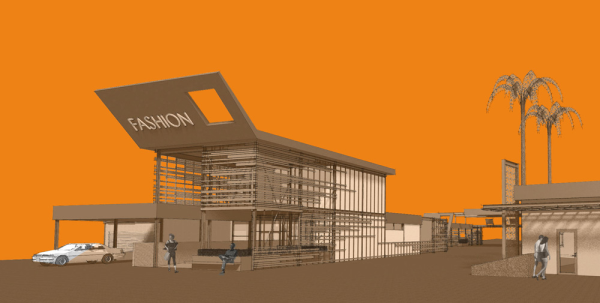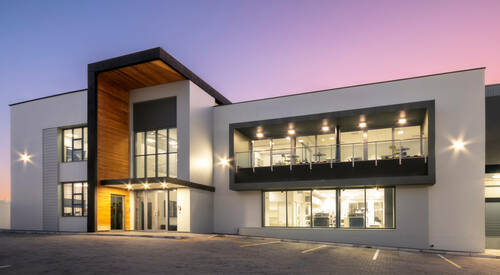Why commercial architects Use BIM to Improve Project Outcomes
Unveiling the Comprehensive Solutions Provided by Commercial Architects for Modern Dope
Commercial Architects offer a critical function in contemporary advancement jobs. They mix layout aesthetics with performance while sticking to regulatory demands. Their knowledge prolongs beyond plain construction, including lasting practices and cutting-edge innovations. As they navigate complicated zoning regulations, Architects team up with numerous stakeholders to bring visions to life. This diverse approach questions about the advancing function of Architects in shaping modern rooms and the effect of their work with future developments.
Recognizing the Function of Commercial Architects in Modern Developments
In modern city landscapes, Commercial Architects play an important function in forming useful and visual areas that satisfy varied company needs. Their knowledge prolongs past plain layout; they browse complicated zoning legislations, building codes, and ecological guidelines. By working together with clients, they determine specific demands, ensuring that each job aligns with the customer's vision while also considering functional aspects such as sustainability and cost-effectiveness. Commercial Architects are adept at incorporating ingenious modern technologies and materials into their styles, improving both the performance and energy performance of buildings. They perform extensive site evaluations to analyze the prospective challenges and possibilities provided by a location. Additionally, effective interaction with service providers and various other stakeholders is vital, making certain that the task progresses efficiently from perception to completion. Inevitably, Commercial Architects are critical in creating areas that not just accomplish functional functions but also add to the overall character and vibrancy of city settings.
Concept Style: Changing Concepts Into Reality
Concept style functions as an essential phase in Commercial architecture, where cutting-edge layout solutions emerge from imaginative thinking. This process relies on collaborative ideation, uniting varied viewpoints to fine-tune and boost preliminary ideas. As ideas form, they transform from abstract ideas right into tangible architectural realities.
Innovative Design Solutions
Changing ideas right into fact is the hallmark of innovative style remedies in Commercial architecture. These remedies mix creative thinking with capability, dealing with the unique needs of modern advancements. By leveraging advanced innovations and sustainable techniques, Architects craft areas that are not only aesthetically attractive yet additionally reliable and versatile. Emphasis on customer experience drives the design process, guaranteeing that environments foster productivity and collaboration. Each project take advantage of a tailored strategy, where concepts are carefully developed to show the client's vision while considering future trends. Innovative style remedies additionally focus on versatility, enabling for alterations over time as business demands evolve. Ultimately, these techniques enhance the overall worth of Commercial spaces, making them crucial in today's affordable landscape.

Joint Ideation Process
Collaboration works as the backbone of the ideation procedure in Commercial style, promoting imagination and technology amongst varied stakeholders. Architects, clients, designers, and area participants participate in vibrant conversations, guaranteeing that all perspectives are considered. This comprehensive approach permits the expedition of various design concepts, urging one-of-a-kind solutions that align with the project's vision. Via workshops and conceptualizing sessions, ideas develop and refine, changing initial concepts right into substantial styles. Innovation likewise plays a crucial duty, with tools such as Building Information Modeling (BIM) helping with real-time partnership and adjustments. Eventually, this collaborative ideation procedure not only enhances the style outcome yet likewise grows a feeling of possession and investment among all parties involved, leading to effective Commercial developments.
Zoning Analysis: Navigating Regulations and Conformity
As programmers start on new projects, recognizing zoning policies is necessary to making sure conformity and staying clear of costly hold-ups. Zoning evaluation plays an essential duty in this process, as it entails assessing regional zoning regulations that dictate land use, building height, thickness, and obstacles. Commercial Architects possess the competence to navigate these complicated policies, aiding clients determine permissible uses and any kind of required differences.
Lasting Layout Practices: Structure for the Future
Sustainable design methods are increasingly necessary in the domain of Commercial design, specifically as ecological problems remain to escalate. Architects prioritize green materials, energy-efficient systems, and design approaches that lessen waste and environmental influence. Including renewable resource resources, such as solar panels and wind generators, permits structures to create their very own power and decrease reliance on fossil fuels.Furthermore, sustainable design highlights the importance of indoor environmental high quality. This includes utilizing natural light, boosting ventilation, and choosing non-toxic products to improve passenger health and wellness and efficiency. Eco-friendly roofings and living wall surfaces are likewise prominent functions that add to biodiversity and urban cooling.Additionally, Commercial Architects often integrate water preservation methods, like rainwater harvesting and drought-resistant landscape design. Via these innovative approaches, they develop rooms that not just fulfill contemporary requirements but likewise foster a lasting future, addressing the expanding need for accountable growth in the contemporary globe.
Project Monitoring: Ensuring Timely and Efficient Implementation
Effective task monitoring is essential for ensuring that Commercial style tasks are finished on schedule and within budget. This duty includes a series of responsibilities, including the coordination of numerous stakeholders, timelines, and sources. Commercial Architects take advantage of their expertise to produce detailed task strategies that outline essential turning points and deliverables, permitting systematic progress tracking.Regular interaction among group members and customers is crucial, fostering openness and assisting in punctual decision-making. Risk management approaches are also employed to determine potential challenges early, allowing positive solutions to be created. By utilizing sophisticated task monitoring devices, Architects can keep an eye on task efficiency in real-time, making modifications as needed to keep efficiency.
Interior Decoration: Developing Functional and Aesthetic Rooms
Inside style plays an essential role in improving both capability and aesthetics within Commercial rooms. Reliable space preparation can maximize operations and boost individual experience, while visual style concepts contribute to a visually attractive setting - commercial architects. With each other, these components develop rooms that Learn More are not only useful but also inspiring
Room Preparation Performance
While maximizing the energy of readily available room, Commercial Architects focus on space preparation performance to produce both practical and aesthetically pleasing environments. This approach entails mindful analysis of the spatial layout to assure ideal usage of every square foot. Architects take into consideration elements such as workflow, availability, and natural light to improve functionality. By tactically putting furnishings, tools, and workstations, they help with movement and communication among individuals, advertising performance. Furthermore, zoning different areas for details features assists in handling noise and personal privacy, producing a harmonious atmosphere. Via effective area preparation, Commercial Architects can reference change restrictions into chances, guaranteeing that each room fulfills the diverse needs of its passengers while sticking to regulative needs and industry requirements.
Visual Layout Principles
Aesthetic layout principles play a necessary role in forming environments that are not only functional however additionally visually enticing. These concepts guide Commercial Architects in producing rooms that reverberate with customers while enhancing brand identification. Crucial element include equilibrium, percentage, and consistency, which function together to develop a cohesive look. Color pattern and products are very carefully chosen to stimulate wanted emotions and sustain the general motif. In addition, illumination plays a critical duty, affecting mood and exposure while highlighting architectural functions. By incorporating these principles, Architects assure that rooms are not just practical but likewise inviting and motivating. Ultimately, effective visual layout cultivates a favorable individual experience, motivating engagement and complete satisfaction in Commercial environments.
Collaboration With Stakeholders: Fostering Effective Collaborations
Successful collaborations in Commercial architecture rest on reliable cooperation with stakeholders, ensuring that every voice is listened to and valued. This collective technique involves engaging different celebrations, consisting of customers, specialists, and neighborhood participants, throughout the style and development procedure. By promoting open communication, Commercial Architects can address concerns, gather understandings, and line up the job's vision with stakeholder expectations.The assimilation of diverse point of views improves creativity and innovation, resulting in even more useful and visually pleasing designs. Routine meetings, responses sessions, and workshops facilitate this dialogue, permitting Architects to adapt their plans in response to stakeholder input. Furthermore, developing trust fund with openness and responsibility reinforces these partnerships, resulting in a smoother my blog job execution.Ultimately, the success of contemporary developments relies on the Architects' ability to browse and integrate differing interests, producing a joint atmosphere that advertises shared objectives and mutual success.
Regularly Asked Inquiries
Just How Do Commercial Architects Take Care Of Budget Constraints Throughout a Task?

What Sorts of Software Do Commercial Architects Generally Make Use Of?
Commercial Architects generally make use of software such as AutoCAD for preparing, Revit for Building Information Modeling, SketchUp for 3D modeling, and task management tools like Microsoft Project to enhance collaboration and simplify process throughout the layout procedure.
Can Commercial Architects Aid With Obtaining Financing for Projects?
Commercial Architects can help in obtaining financing for jobs by preparing detailed proposals, assisting to express layout visions, and giving economic forecasts that can enhance the chance of protecting needed funding from capitalists or banks.
Just How Do Architects Ensure Safety Throughout the Building Refine?
Architects guarantee security throughout construction by carrying out rigorous design standards, collaborating with engineers, performing regular website inspections, adhering to local policies, and cultivating interaction amongst all stakeholders to minimize risks and advertise a safe workplace.
What Recurring Assistance Do Architects Provide After Job Conclusion?
After job completion, Architects supply ongoing assistance via upkeep assessments, efficiency assessments, and layout adjustments. They assure buildings fulfill developing needs, address potential concerns, and keep conformity with guidelines, cultivating a long-term connection with customers.